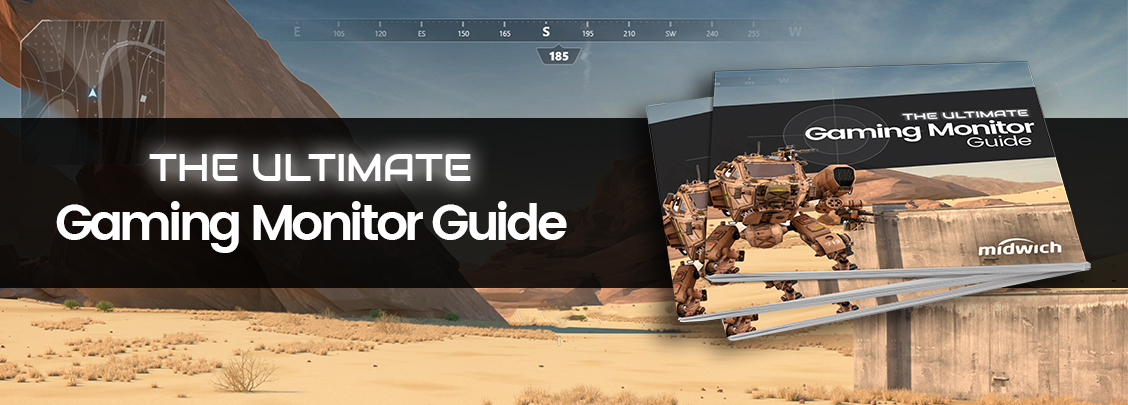What To Look For When Buying A Gaming Monitor
View The Ultimate Gaming Monitor Guide
As PC games are becoming more immersive than ever, gamers are upgrading their kit to make sure they have the best gaming monitor possible. There are many things to consider when getting a monitor and with a wide array of displays to choose from customers are spoilt for choice. Use this 2019 Gaming Monitor Guide to help make the best choice.
The Gaming Market
The UK gaming market as a whole grew by 10% in the past year to a record £5.7bn industry and the PC hardware industry also grew by 18.4%; with more gamers choosing to play in front of a monitor versus sitting in front of their TV.
PC gamers are considered more ‘serious’ gamers spending more on their set up. A budget PC gamer will still spend between £650-750 on their set up, whereas the average PC gamer will spend more between £1000 and £1200.
With new games packed with real, bright and high definition content, gamers are increasingly upgrading their display solutions to transport their experience into reality. We are also beginning to see a change in the gaming market, with gaming platforms like Google’s Stadia removing the need to fork out thousands of pounds custom building their computer, allowing end-users to invest in more powerful monitors, completely bypassing the expense of computers.
However, it may be a while before we see a majority of PC gamers completely ignoring the power of their computer and solely focusing on monitors, at the moment these two-go hand in hand.
But with a wide array of PC monitors to choose from, it can be difficult to know which is best, there are many things to consider when buying a gaming PC; Resolution, Refresh Rates, Adaptive Syns, Panel Technology, Response Time and Screen Size.
Resolution

The most important aspect to consider when choosing a gaming monitor is the display resolution. The three standard resolutions are:
- 1080p
- 1440p
- 2160p
These are also known as Full HD, QHD/2K and UHD/4K.
Fundamentally, a higher resolution means there will be more pixels on the screen resolution in a clearer picture and smoother gameplay.
Resolution is very hardware heavy, as it is important to consider your hardware limitations when choosing a gaming monitor. If your GPU, graphics processing unit, cannot process a high resolution, it will cause in-game lagging.
1440p/QHD/2K is becoming the standard monitor resolution size for the average gamer, as only the most powerful modern GPUs are able to process 2160p.
That being said, if your GPU can’t process high resolution, you can set powerful monitors to play on lower resolution settings, future-proofing your gaming rig, ready for a new GPU than can comfortably run a higher resolution.
Refresh Rates

Measured in Hertz (Hz), the refresh rate measures how many times the monitor can refresh the displayed image per second.
Refresh rates come in three different sizes:
- 60 Hz
- 144 Hz
- 240 Hz
Take into account how many FPS, frames per second, your GPU can handle, there is no point investing in a monitor with a high refresh rate if your GPU can’t run games with such a high refresh rate.
Adaptive Syncs

Screen Tearing – what happens when your monitor is working in overtime. Trying to display an FPS higher than its refresh rate.
Monitors equipped with either AMD Freesync or Nvidia G-Sync technology eliminates screen tearing. A lot of monitors already include this, but it is certainly a key feature you will want to look out for!
These two technologies are very similar, the main difference being price.
AMD Freesync costs exactly what it says in its name, it is free, adding no extra cost to the cost of a monitor. This technology is only compatible with AMD graphic cards.
NVIDIA G-SYNC does add a premium to the cost of a monitor, typically around £80-120 and only works with NVIDIA cards.
Panel Technology

There are two different types of panel technology: IPS Panel and
TN panels. In essence IPS panels create prettier displays, with better visual features. Whereas TN panels perform with a faster response time.
Response Time

Pixel response time is measured in milliseconds (ms) and represents how much time a single-pixel needs to switch from black to white, or between two different shades of grey.
A lower response time will perform smoother movements and higher response times can lead to motion blur because pixels can’t fully change colours quick enough.
Currently, TN panels have a minimum response time of 1 ms response time and IPS panels can only reach a minimum of 4 ms response time. Gamers looking for visual quality will sacrifice response time for more vibrant colours and better viewing angles, whereas gamers not fussed about the accuracy of their colour reproduction, will choose the lower response time eliminating motion blur.
Screen Size

Most console gamers will sit 3-4ft away from their screen and will invest in the largest of screens to immerse themselves in the experience. PC Gamers don’t need to worry about this, as they normally sit about an arm’s length away from their screen.
The perfect balance between visual clarity and viewing comfort for most gamers is normally between 21 inches and 27 inches.
Monitor screen size usually goes together with resolution, with larger screens comfortably supporting higher resolutions.

Gaming Monitor Buying Guide
Keep all of the important factors above in mind when choosing a gaming monitor and you can rest assured you will be making a smart purchase.
Check out our Ultimate Gaming Monitor Buying Guide.
